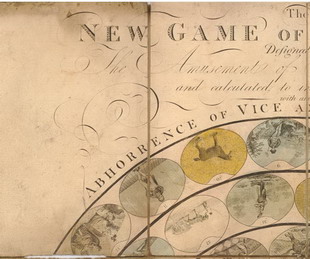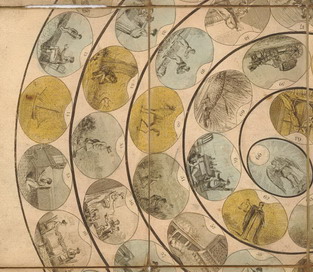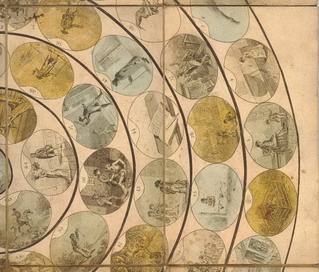Giochi dell'Oca e di percorso
(by Luigi Ciompi & Adrian Seville)
(by Luigi Ciompi & Adrian Seville)

|
Giochi dell'Oca e di percorso
(by Luigi Ciompi & Adrian Seville) |

|
 |

Torna alla ricerca giochi (back to game search) |
 |
| New (The) Game of Emulation. Designed for the Amusement of Youth of both Sexes and Calculated to Inspire their Minds with an Abhorrence of Vice and a Love of Virtue. | ||
 |
Versione stampabile
 |
Invia una segnalazione

|
      |
primo autore: | Anonimo |
| secondo autore: | Harris John | |
| anno: | 1804 | |
| luogo: |
Inghilterra-Londra |
|
| periodo: | XIX secolo (1°/4) | |
| percorso: | Percorso di 66 caselle numerate | |
| materiale: | carta incollata su tela (engraving on paper with linen backing) | |
| dimensioni: | 571X464 | |
| stampa: | Litografia colorata a mano (hand-coloured engraving) | |
| luogo acquisto: | Donazione Lady C. Schreiber | |
| data acquisto: | ||
| dimensioni confezione: | ||
| numero caselle: | 66 | |
| categoria: | Infanzia, educazione, pedagogia, favole e fiabe | |
| tipo di gioco: | Gioco di percorso | |
| editore: | Published by J. Harris Succ. to E.Newbury at the orig. Juvenile Library, Corner of St. Paul’s Church | |
| stampatore: | Published by John Harris Successor to E. Newbury | |
| proprietario: | British Museum. Donazione Lady Charlotte Schreiber | |
| autore delle foto: | ©British Museum | |
| numero di catalogo: | 2413 | |
| descrizione: |
Gioco di 66 caselle numerate, circolare, antiorario, centripeto. Vedi anche esemplare Collezione Seville (Arch. n°1017). REGOLE: non riportate sul tavoliere. CASELLE: mute. REFERENZA 1 The New Game of Emulation. Designed for the Amusement of Youth of both Sexes and Calculated to Inspire their Minds with an Abhorrence of Vice and a Love of Virtue. (V&A Museum) The morality game contains many allegories relating to the world a child may come in contact with: a shepherd, school, church and bishop, rocking horse. All 66 emblematic figures are designed to teach children to cheerfully exert themselves to obtain an honorary prize while being perfectly aware of the consequences of disgrace. The game was advertised as follows: 'It is universally acknowledged that a spirit of emulation should be constantly encouraged in the rising generation, as the surest means of facilitating their progress in the paths of literature, and impressing their opening minds with the love of virtue. Youth are ever anxious for applause and remuneration, and will cheerfully exert themselves to obtain an honorary prize, even when admonitions and menaces prove unavailing. ...[T]hey will be led, almost imperceptibly, to admire and adopt the virtues of Obedience, Truth, Honesty, Gentleness, Industry, Frugality, Forgiveness, Carefulness, Mercy, and Humility; and to view in their real colours the opposite vices of Obstinacy, Falsehood, Robbery, Passion, Sloth, Intemperance, Malice, Neglect, Cruelty and Pride." Physical description Design: engraving, coloured by hand to show 66 medallions representing good and bad moral characteristics; mounted on linen; anticlockwise N°of squares: 66 Squares illustrated: all Square numbering: all 1 to 66 Squares titled: in booklet Subject of starting square: Turnpike Gate Subject of ending square: Virtue its Own Reward Place of Origin: London Date: 20/12/1804 Artist/maker: Harris, John Materials and Techniques: Hand-coloured engraving on linen Dimensions: Height: 58.2 cm; width: 45.8 cm Object history note: slip case of marbled paper with pictorial label showing Apollo and Cupids It contains many allegories relating to the world a child may come in contact with, a shepherd, school, church and bishop, rocking horse. All 66 emblematic figures are designed to teach children to cheerfully exert themselves to obtain an honorary prize while being perfectly aware of the consequences of disgrace and naturally dread it. Historical context note Rewards: receipt of counters, forward movement, extra spins Forfeits: payment of counters, backward movement and missing turns N°of Players: 2 to 20 Equipment required: teetotum marked from 1 to 6, markers and 12 counters for each player Rules: RULES AND DIRECTIONS FOR PLAYING THE NEW GAME OF EMULATION DESIGNED FOR THE AMUSEMENT OF YOUTH OF BOTH SEXES WITH AN ABHORRENCE OF VICE AND A LOVE OF VIRTUE. LONDON: PRINTED FOR J HARRIS, SUCCESSOR TO E NEWBERY AT THE ORIGINAL JUVENILE LIBRARY CORNER OF ST. PAUL'S CHURCH-YARD 1810. ADVERTISEMENT It is universally acknowledged that a spirit of emulation should be constantly encouraged in the rising generation, as the surest means of facilitating their progress in the paths of literature, and impressing their opening minds with the love of virtue. Youth are ever anxious for applause and remuneration, and will cheerfully exert themselves to obtain an honorary prize, even when admonitions and menaces prove unavailing. They are, also, perfectly aware of the consequences of disgrace, and naturally dread it, as the severest punishment. Convinced of the truth of these observations, tte author of the game now laid before the public, has endeavoured t instil into the minds of young people such sentiments as are most likely to conduce to their permanent felicity; for, whilst amusing themselves and their juvenile companions with their teetotum and counters, they will be led, almost imperceptibly, to admire and adopt the virtues of Obedience, Truth, Honesty, Gentleness, Industry, Frugality, Forgiveness, Carefulness, Mercy, and Humility; and to view in their real colours the opposite vices of Obstinacy, Falsehood, Robbery, Passion, Sloth, Intemperance, Malice, Neglect, Cruelty and Pride. The other emblematical figures are calculated to render the game as interesting as possible, and will be found to conduce equally to the rational amusement and improvement of the mind. DIRECTIONS FOR PLAYING I. The Game of Emulation is play with a teetotum, bearing 6 faces and marked 1, 2, 3, 4, 5, 6. Any any number of persons, from two to twenty, may partake of the amusement. II. Every player must be furnished with twelve counters, the value of which may be fixed by mutual consent; and also with another counter, called a mark, which (being chosen of some particular colour) may distinguish him from his companions. III. Each player must deposit four counters in the back, at the commencement of the game. IV. When the parties have agreed respecting the order in which they are to play, the first person spins twice and casting up the number of points spun at each time, he fixes his mark on the symbolical figure corresponding with his total number. And when it is his turn to spin again, he counts from the figure which bore his mark last. V. As every symbol subjects to player to certain fines, rewards or removals, a thorough knowledge of their meaning, and the annexed Rules, must be acquired; and this may be done with even a moderate share of attention. VI. No. 66, which represents Virtue as its own reward, is the end of the game. If therefore any persons who is near the end, happens to spin a number beyond it, he must go back as many steps from the place where his mark is, as he has spun beyond 66. Thus, if a persons has his mark on 62, from which he has only to spin four points more to reach the end and should spin eight points in his two goes, instead of the four which he wanted, he must count back his four exceeding points from his position on 62, which will bring him upon No. 58; there he must remain till his next run comes to spin and then he may advance again. NB: in this case, the player is exempted form the fines attending the symbolical figures to which he may have occasion to return. Booklet goes on to list the explantion of the 66 Emblematical Figures and set out the rewards or forfeits each have. Rules placement: booklet, Printed by H. Bryer, Bridge Street, Blackfriars London, 1810 Descriptive line: Hand coloured moral race game, The New Game of Emulation, published in England by John Harris in 1804. REFERENZA 2 WHITEHOUSE, Francis Reginald Beaman, (pag. 48): EMULATION (The new game of). Designed for the Amusement of Youth of both Sexes and calculated to inspire their Minds with an Abhorrence of Vice and a Love of Virtue. London, Published Dec. 20th, 1804 by John Harris (Successor to E. Newbery) at the original Juvenile Library, Corner of St. Paul’s Church Yard. An engraving size 17 ¼ in X 22 in, hand-coloured and mounted in 12 sections on linen, contained in slip-in case with picture label on front. The game is a race over a snail-shell type track of ovals in an anti-clockwise direction, commencing at No 1 Turnpike Gate, and passing through various Virtues and Vices until the centre, 66, is reached, where "Virtue is its Own Reward". REFERENZA 3 "British Museum" - AN322870001© The Trustees of the British Museum 1893, 0331. 129 Title: "The New Game of Emulation". Materials: paper Techniques: hand-coloured, etching Production person: Published by John Harris Production place: Published in London Date: 1804 Schools /Styles: British Description: Circular game-board with 66 numbered pictorial compartments, some illustrating moral scenes, the last compartment showing an angel, in a board slip-case with printed label with a scroll, bearing the title. Hand-coloured etching backed on linen. Inscription Content: Lettered with the title: "The/ New Game of Emulation/ designed for/ The Amusement of Youth of Both Sexes/ and calculated to inspire their minds/ with an/ Abhorrance of Vice and a Love of Virtue"; at bottom "London/ Published Dec 20th 1804/ by/ John Harris Successor to E. Newbury at the/ Juvenile Library/ Corner of St Paul's Church Yard". Dimensions: Height: 571 millimetres. Width: 464 millimetres. Subject: education REFERENZA 4 "The New Game of Emulation (Le Nouveau Jeu d'Emulation) est une gravure rehaussée à la main, publiée par John Harris le 20 décembre 1804. Ce jeu comporte de nombreuses allégories relatives au monde familier de l'énfant: un berger avec son troupeau, une école, une église et un éveque, et meme un cheval à bascule. Les 66 figures emblématiques sont toutes conçues pour apprendre aux enfants "à s'exercer joyeusement à obtenir un prix honorifique", tout en étant "parfaitement conscients des conséquences de la disgrace, ce qui doit etre crainte"." (GOODFELLOW Caroline) REFERENZA 5 "The New Game of Emulation" is a hand-coloured engraving, published by John Harris en December 20th, 1804. It contains many allegories relating to the world a child may come in contact with- a shepherd tending his flock, a school, a church and a bishop, and even a rocking horse. All the 66 emblematic figures are designed to teach children to "cheerfully exert themselves to obtain an honorary prize" while being "perfect aware of the consequences of disgrace and naturally dread it"." (GOODFELLOW Caroline) |
|
| bibliografia: |
1) WHITEHAUSE, F.R.B.: "Table Games of Georgian and Victorian Days", London, Peter Garnett, 1951. 2) GOODFELLOW, Caroline: "A Collector's Guide to Games and Puzzles". Secaucus, New Jersey, Chartwell Books-London, Quintet Publishing Limited 1991. 3) GOODFELLOW, Caroline: "The Development of the English Board Game, 1770-1850", in Board Games Studies 1, 1998. 4) GOODFELLOW, Caroline: "Jeux de société. Le guide du collectionneur des jeux de société depuis le XVIIIe siècle jusqu’à nos jours", (Edizione francese). Carrousel MS, 2001. 5) SEVILLE, Adrian: "The Game of Goose: and its influence on cartographical race games". Journal of the International Map Collectors' Society, Winter 2008 N°115 2008. 6) SEVILLE, Adrian: "The geographical Jeux de l'Oie of Europe." In "Belgeo" 2008 3-4 2008. 7) GOODFELLOW, Caroline: "How We Played: Games From Childhood Past", History Press, 2012. 8) LIMAN, Ellen: "Georgian and Victorian Board Games: The Liman Collection", Pointed Leaf Press, 2017. 9) NORCIA, Megan A.: "Gaming Empire in Children's British Board Games, 1836-1860". Studies in Childhood, 1700 to the Present. Routledge, 2019. |
|
| "The Development of the English Board Game, 1770-1850" (Caroline G. Goodfellow) | ||
| Games of Moral Improvement. "Table Games of Georgian and Victorian Days". (Francis Reginald Beaman, Whitehause) | ||
Vai alla ricerca giochi Vai all'elenco autori